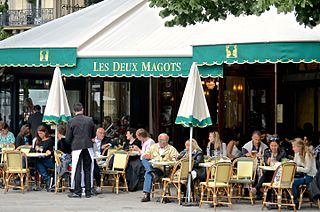
The 6th arrondissement of Paris is one of the 20 arrondissements of the capital city of France. In spoken French, it is referred to as le sixième.

The 14th arrondissement of Paris, officially named arrondissement de l'Observatoire, is one of the 20 arrondissements of the capital city of France.

Vavin is a station of the Paris Métro on line 4 on the border of the 6th arrondissement and 14th arrondissement, under Place Pablo-Picasso at the intersection of Boulevard du Montparnasse and Boulevard Raspail. It is named after the nearby rue Vavin, named after 19th-century statesman Alexis Vavin (1792-1863).

Raspail is a station of the Paris Métro, serving Line 4 and Line 6 in the 14th arrondissement. The station is now fitted with Platform screen doors, due to the Line 4 being fitted for automation.

Edgar Quinet is a station on Line 6 of the Paris Métro. Located at the intersection of Boulevard Edgar Quinet, the Rue du Montparnasse and Rue de la Gaîté, it is situated in the 14th arrondissement.

Sèvres–Babylone is a station on Lines 10 and 12 of the Paris Métro. It is located at the intersection of Boulevard Raspail and rue de Sèvres, on the border of the 6th and 7th arrondissements. Rue de Sèvres boasts two flagship Paris fashion stores: Le Bon Marché at number 22 and Hermès at number 17.

Denfert-Rochereau is a station on the Paris Métro in France. An adjacent station with the same name is served by RER B.

The Wall of the Ferme générale was one of the several city walls of Paris built between the early Middle Ages and the mid 19th century. Built between 1784 and 1791, the 24 km wall crossed the districts of the Place de l'Étoile, Batignolles, Pigalle, Belleville, Nation, the Place d'Italie, Denfert-Rochereau, Montparnasse and the Trocadéro, roughly following the route now traced by line 2 and line 6 of the Paris Métro. The wall was demolished in the early 1860s, although elements of some of its gates remain.

The quartier du Petit-Montrouge is number 55 of the 80 quartiers administratifs in Paris. It lies in the 14th Arrondissement, in the south of the capital. It owes its name to the adjacent commune of Montrouge, of which it formed a part before 1860. It is familiar as the quartier Alésia, from the name of a street that bisects it and from the principal Métro station that serves it, although the quartier Alésia does not exactly overlap the quartier du Petit-Montrouge.

Denfert-Rochereau station is a railway station in Paris. It was one of the first stations of the French railway network, and is still in use as a station of Paris' RER line B.
The Boulevard Auguste-Blanqui is a boulevard in the 13th arrondissement of Paris. It is one of the main arteries linking the Place d'Italie with the Place Denfert-Rochereau.
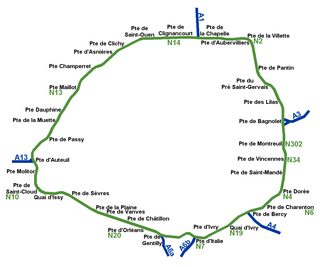
While Paris is encircled by the Boulevard Périphérique, the city gates of Paris are the access points to the city for pedestrians and other road users. As Paris has had successive ring roads through the centuries, city gates are found inside the modern-day Paris.
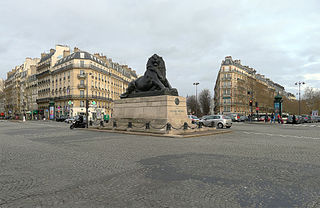
The Place Denfert-Rochereau, previously known as the Place d'Enfer, is a public square located in the 14th arrondissement of Paris, France, in the Montparnasse district, at the intersection of the boulevards Raspail, Arago, and Saint-Jacques, and the avenues René Coty, Général Leclerc, and Denfert-Rochereau, as well as the streets Froidevaux, Victor-Considérant and de Grancey. It is one of the largest and most important squares on the left bank of the Seine.
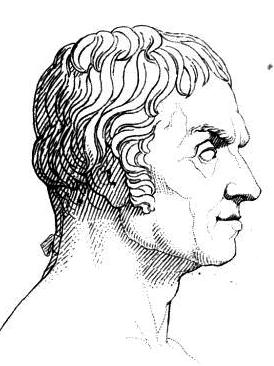
Jean-Guillaume Moitte was a French sculptor.
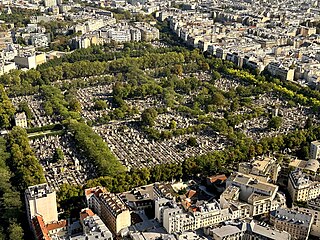
Montparnasse Cemetery is a cemetery in the Montparnasse quarter of Paris, in the city's 14th arrondissement. The cemetery is roughly 47 acres and is the second largest cemetery in Paris. The cemetery has over 35,000 graves and approximately a thousand people are buried here each year.

Croix-Rouge station was the first terminus of Line 10 of the Paris Métro. It opened in 1923, but closed in 1939. The station was situated in the 6th arrondissement of Paris, between Sèvres–Babylone and Mabillon.

Pierre Philippe Marie Aristide Denfert-Rochereau,, was a French serviceman and politician. He achieved fame by successfully defending besieged Belfort during the Franco-Prussian War: this earned him the soubriquet The Lion of Belfort.
Shamai Haber was a sculptor who lived and worked in Paris, France. He died in 1995 in Paris.
The Barrière d'Enfer is a pair of tollhouses in Paris that once served as a gate through the Wall of the Farmers-General at the current location of the Place Denfert-Rochereau.
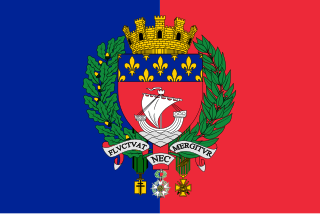
The following outline is provided as an overview of and topical guide to Paris:



















